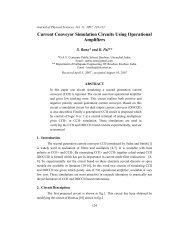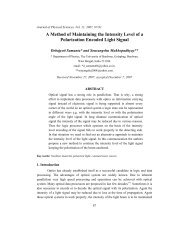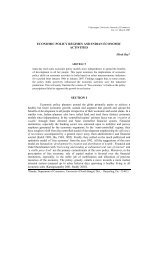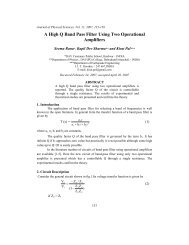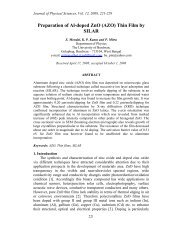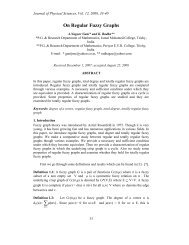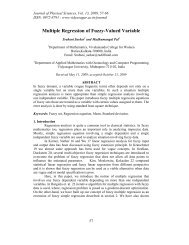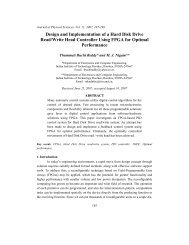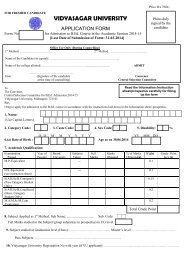VIDYASAGAR UNIVERSITY JOURNAL OF COMMERCE
VIDYASAGAR UNIVERSITY JOURNAL OF COMMERCE
VIDYASAGAR UNIVERSITY JOURNAL OF COMMERCE
Create successful ePaper yourself
Turn your PDF publications into a flip-book with our unique Google optimized e-Paper software.
CORPORATE GOVERNANCE AND TRANSPARENCY SCENARIO IN ASIA<br />
Bank (1999) defines ‘good governance’ as based on four pillars: transparency,<br />
accountability, predictability and participation, recognizing that “their application must be<br />
country-specific and solidly grounded in the economic, social and administrative capacity<br />
realities of the country”.<br />
“CG comprehends that structure of relationships and corresponding responsibilities among a<br />
core group consisting of shareholders, board members, corporate managers designed to<br />
‘best’ foster the competitive performance required to achieve the corporation’s primary<br />
objective,” observes Organization for Economic Cooperation and Development (OECD). It<br />
is concerned with wider accountability and responsibility of the directors towards ‘key’<br />
stakeholders of the corporations, viz., employees, consumers, suppliers, creditors and the<br />
wider community. Oman and Blume (2005) have aptly pointed out, “Corporations around<br />
the world are realizing that better CG adds considerable value to their operational<br />
performance. The poor quality of local systems of CG lies at the heart of one of the greatest<br />
challenges facing most countries in the developing world.”<br />
In developing nations, both ‘voluntary’ guidelines and more ‘coercive’ codes of best practice<br />
have already been issued. For example, both “the Code of Best Practices” issued by the<br />
Brazilian Institute of Corporate Directors and the “Code of Corporate Governance” issued<br />
by the Corporate Governance Committee of the Mexican Business Coordinating Counsel are<br />
wholly ‘aspirational’ and not linked to any ‘listing’ requirements. Similarly, the<br />
Confederation of the Indian Industry (CII’s Code) and the Stock Exchange of Thailand Code<br />
are designed to build awareness within the corporate sector of governance best practice, but<br />
are not, at this time, linked to stock exchange listing requirements. In sharp contrast to these,<br />
Malaysia’s Code on Corporate Governance, the Code of Best Practice issued by the Hong<br />
Kong Exchange, and South Africa’s King Commission Report on CG, all contemplate<br />
mandatory disclosures concerning compliance with their recommendations. Many<br />
companies are now thinking of governance as something more than just an area reporting to<br />
the Corporate Secretary or Legal Counsel. Recently, the rise of the “Chief Governance<br />
Officer” mirrors the appointment of the Chief Ethics Officer by many companies that have<br />
been plagued by scandal or crisis (e.g. MCI). As these roles become institutionalized, they<br />
will emerge as the engines of the next generation of governance ‘best’ practices designed to<br />
add value, instead of simply complying with external regulations and codes.<br />
Many aspects of a company’s structure, behavior, ethical standards and culture, and the<br />
legal, regulatory, community and media environments in which it operates, impacts the<br />
governance structure of a company. ‘Good’ governance is not simply a matter of adopting a<br />
set of rules, but a continuous process of implementing tailored strategic initiatives to<br />
maximize long-term value. The rules does matter, of course, but rules have changed<br />
significantly in recent years, with the introduction of many national, international regulations<br />
and codes defining ‘best practice’. While some of the country ‘specific’ recommendations<br />
may vary, most best-practices prescriptions focus on improving practices and disclosure in<br />
five ‘core’ areas as outlined in Box-1. “The Combined Code, 2003 (of the UK) is a practical<br />
implementation of this idea comprising two parts: principles of good governance and a code<br />
of best practice,” (Chang et al., 2006).<br />
4 Vidyasagar University Journal of Commerce





